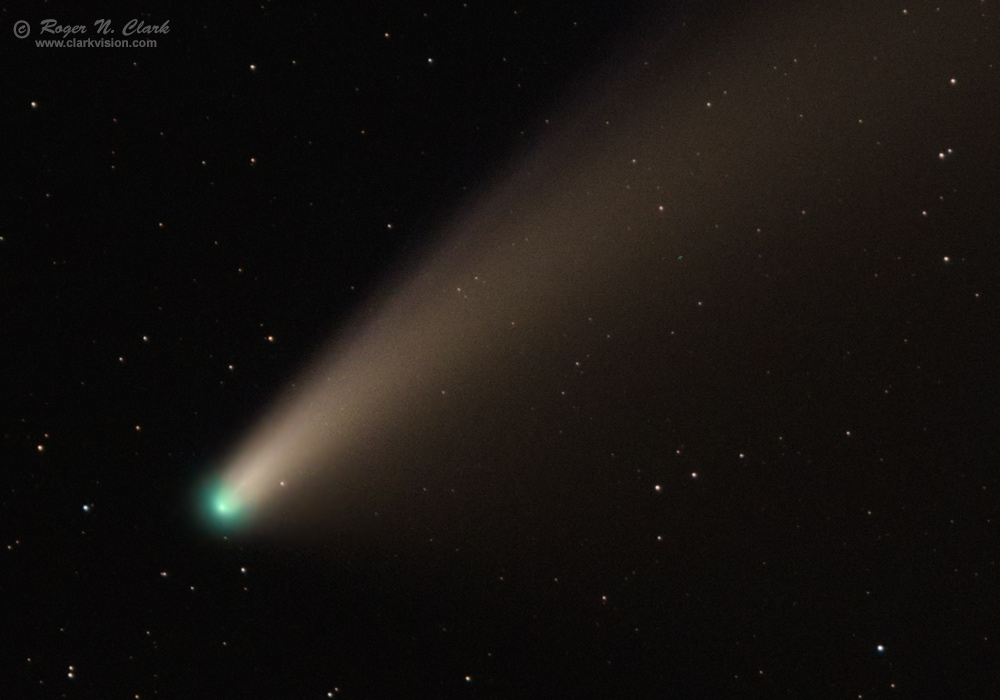| Home | Galleries | Articles | Reviews | Best Gear | New | About | Contact | Gallery Index | Previous |
Next |

| Home | Galleries | Articles | Reviews | Best Gear | New | About | Contact | Gallery Index | Previous |
Next |

Comet NEOWISE put ion a dazzling show in the evening in July, 2020 after making its perhileon passage on July 3. From dark skies, the comet was easily seen with the unaided eye, showing a tail over 10 degrees long. At a dark site in the Colorado Rocky Mountains the view in 7x50 binoculars showed the a yellow-brown dust tail, a green head and a gray ion tail (the contrast was too low to see blue and purple color shown in the image).
The comet displays two tails: The blue tail (Type 1) is an ion tail. The blue is fluorescence from molecules ionized by solar ultraviolet light. In this short exposure, the ion tail is not readily seen. The yellow-brown dust tail (Type 2) is dragged into a fan shape by the solar radiation pressure on tiny dust grains, along with the orbital motion of the comet. The yellow is reflected sunlight off of small dust particles. The green around the nucleus is fluorescence from diatomic carbon (C2) with possible contribution from cyanogen (CN).
Technical. This image was obtained with a stock Canon EOS 90D Camera and Sigma 105mm f/1.4 DG HSM Art Lens at f/1.4. Tracking the comet with a Fornax Lightrack II and no guiding. The image is a stack of 23 short exposure images. The exposures ranged from 1/4 to 5.2 seconds (45.4 seconds total exposure) were combined for a High Dynamic Range (HDR) composite to show detail in the green nucleus region to the dust tail. The image is shown at full resolution, 6.3 arc-seconds / pixel.
This is a natural color image. Post processing: Raw conversion with Rawtherapee with settings tuned for astrophotos, including maintaining star color in saturated stars. Rawtherapee processing settings described here. Output color space was Rec.2020 to match the future of high dynamic range TVs and the web presentation here is sRGB. This image is not stretched at all, and the colors look close to the out-of-camera jpeg images. The colors are similar to the visual view.
Online are images of the comet with a blue ion tail seem to also show a white dust tail. The dust is distinctly yellow brown, both visually and in short exposures with no processing as shown here. So images with a white dust tail and blue ion tail are not natural color. They probably set the white balance to tungsten or something similar, and/or did not apply the camera color matrix correction. The comet is illuminated by the sun, so sunny (daylight) white balance is what is needed for natural color.
The Exposure Factors, CEF, CEFA are measures of the relative amounts of light received from a subject. It can be used to fairly compare wildly different lens/telescope apertures and exposure times. For this image on the thirty 15-second images on the tail:
Modern DSLRs like the Canon 90D include on sensor dark current suppression and low fixed pattern noise at ISOs around 1600 and higher, making no need for dark frame subtraction. Modern raw converters correct for light fall-off and also correct for hot/dead/stuck pixels. This makes processing low light images easy: simply align and average.
To learn how to obtain stunning images like this, please visit my Extensive Articles on Photography .
Keywords to this image = astrophoto-1 night low-light digital_astro comet canon_90d rnc-color-stretch
Image ID: comet-neowise-rnclark-105mm-c07-20-2020-IMG_8613-35-c1.d-1000s.jpg
| Home | Galleries | Articles | Reviews | Best Gear | Science | New | About | Contact |
Last updated November 08, 2025